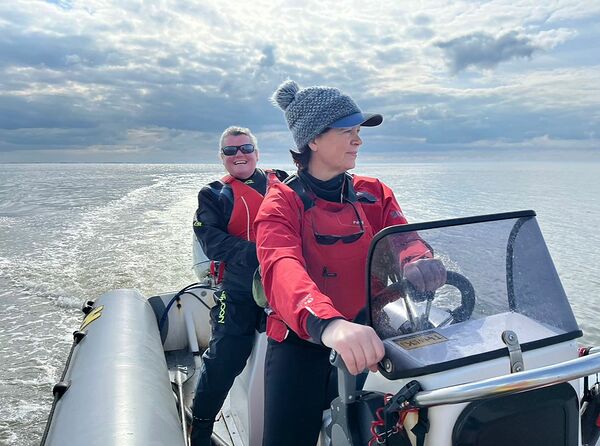RYA Powerboat Level 2
RYA Powerboat Level 2 (£350)
To see dates and times of each course and to book on, click HERE
Where? Snettisham Beach Sailing Club
How Long? 3 Days (16 hours)
How Old? Minimum age is 12 (Candidates under the aged 12-15 will be issued with an endorsed certificate-
"The holder should only use powered craft under the supervision of a responsible adult.")
How Many? 1:3
How Much? £350
ABOUT THE COURSE:
At Snettisham, we run our powerboat courses over 3 days. This is to ensure that we can maximise time afloat with the amount of time that the tide is in here.
The purpose of the course is to teach seamanship and boat-handling skills in powerboats.
Our courses are run in 5m Humber RIBs on the sea, and will possibly be combined with use of tiller steer boats on our Pit, if appropriate.
Powerboat Level 2 is the recognised minimum standard for powerboat skippers. If you hold the Powerboat Level 2 and are a British Resident or British Passport holder you are eligible for an International Certificate of Competence (ICC) for power craft up to 10m in length.
RYA POWERBOAT LEVEL 2 COURSE SYLLABUS:
PRACTICAL
Launching and Recovery
Knowledge of:
Use of a trailer or launching trolley, consideration of launching and sea conditions, including hazards
and obstructions. Number of persons required to launch & recover. Construction width and condition of
slipway. Steep/slippery slipways, beach launching, lee shores. Care of trailer bearings, hitch, lashings,
ties, lights and winch
Can:
Prepare the boat, lines, fenders, safety equipment, fuel tanks, lines and secure gear on board.
Carry out prestart checks, engine starting and stopping Demonstrate the use of an appropriate
length kill cord at all times. Carry out low speed manoeuvres including turning in a confined area,
effect of wind on bow and holding off. Demonstrate an awareness of the danger of flooding when going
astern.
Boat Handling
Knowledge of:
Loading: effect on handling and performance, effect on balance and trim, CE plate and manufacturers
recommendation. Displacement boats: handling ahead and astern, carrying away
Understands:
Crew members: minimum number in high speed craft, keeping a lookout. Awareness of other water
users, including effect of wash. Steering, controls, effect of current or tidal stream High speed
maneuvering: planing, trim tabs and power trim.
Planing boats:
Propeller angle and immersion, shallow drive, high/low speed handling, tiller/console steering
Can:
Carry out highspeed manoeuvres including Sturns and Uturns
Securing to a buoy
Understands:
Preparation of mooring warp, Use of a boat hook, method of approach, crew communication, making
fast, procedure when overshooting
Can:
Approach and secure a buoy
Anchoring
Understands:
Method of approach in various conditions, taking way off, crew communication depth of water, holding ground, scope required, check holding, depth of water, holding ground, scope required
Knowledge of:
Types of anchor, Stowage and attachment to boat, preparation of anchor, chain and warp, weighing
Anchor
Can:
Approach and anchor correctly, weigh anchor correctly
Leaving and coming alongside
Understands:
Preparation and use of painter, lines and fenders, attachment to boat, stowage under way, speed and
angle of approach, wind effect, method of approach in tidal stream or current
Can:
Make fast alongside, use springs, leave ahead or astern
Man over board techniques
Knowledge of:
Recovery of man overboard
Can:
Take immediate action, observe the man overboard, carry out the correct return with awareness of
propeller, approach and recover the man in the water
THEORY
Knowledge of:
Types of craft: advantages and disadvantages of different hull forms with respect to sea keeping ability,
Engines and drives advantages and disadvantages of outboard, inboard and outdrive units single and
twin screw boats, choice and use of fuels, Siting of fuel tanks, fuel lines, batteries, wiring and fire
extinguishers Routine engine maintenance checks, basic fault diagnosis Close down procedure
Advice to inland drivers about coastal waters, Use and limitations of GPS, Application of local bye
laws, especially around commercial shipping, Sources of weather information
Understands:
Awareness of other water users, Communication with other craft hand and sound signals, Disabled
craft, Emergency action preventing sinking, Adrift alternative means of propulsion, Towing and being
towed, Fire precautions and fire fighting, Rope work, Distress signals and the Mayday call
Can:
Apply IRPCS, principally rules 5,7,8,9, 1219
COASTAL
Knowledge of:
Pilotage and passage planning, CG66 Small Craft Safety Scheme
Understands:
Charts, chart symbols, buoyage systems, Tides and tidal streams
Can:
Use steering and hand bearing compasses, Apply Section A on coastal waters
This information was taken from the RYA powerboat log book.

Last updated 14:43 on 23 July 2025











